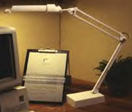Normal Vision Changes
Just as the body changes with age, our eyes change, too. Our eyes function differently in our 60s, 70s, 80s, and 90s than they did in our 30s. Such vision changes are normal, offer few serious risks, are not caused by disease or illness, and, generally, can be corrected with eyeglasses, contact lenses, or surgery. Other vision changes, however, can be symptoms of serious eye disease.
Although many age-related vision changes are normal, they can cause problems by interfering with various everyday activities.
How do you know the difference between a “normal” change in vision and a change that is more serious? To determine the answer, your doctor will want to know your specific symptoms; thus, the best way to answer this question is to visit your eye care professional for a comprehensive eye examination.
Kaye Olson, Coordinator of the Coping with Vision Loss Study

Kaye Olson has experienced her own personal journey through vision loss after seeing her eye doctor for what she thought would be a routine eye exam.
“I said to my husband one morning, ‘I’m calling to have my eyes examined. I think I need a prescription change.’ I had covered each of my eyes separately, and the left eye was blurred, but I wasn’t yet concerned. Initially, an ophthalmologist examined me at the clinic, but he told me that I must see a retinal specialist within 24 hours.”
“Following my eye exam with the retinal specialist, two statements propelled me into shock and disbelief: ‘You have a branch retinal vein occlusion with permanent complications, including vision loss,’ and ‘There is no known treatment for you.’ My physician compared it to a stroke on the retina.”
Learn more about ways to protect your eye health, including:
- The different types of eye care professionals
- The components of a comprehensive eye examination
- Questions to ask your eye doctor
- Check out our Getting Started Kit for more ideas to help you live well with low vision.
Vision Changes in the Older Eye
The most common age-related vision changes and their effects on everyday activities can include the following:
Increased sensitivity to glare
 Being able to see clearly when exposed to reflected light or bright sunlight—especially outdoors on a sunny day or in a hallway with highly polished floors—requires absorptive sunglasses or other adaptations to control glare and to see the environment clearly.
Being able to see clearly when exposed to reflected light or bright sunlight—especially outdoors on a sunny day or in a hallway with highly polished floors—requires absorptive sunglasses or other adaptations to control glare and to see the environment clearly.
Increased lighting requirements
 Most older adults require three to four times more light than previously to perform many everyday activities. Seeing clearly enough to read, write, sew and knit, or perform home repairs usually requires a brighter, more focused light in addition to reading glasses or bifocals.
Most older adults require three to four times more light than previously to perform many everyday activities. Seeing clearly enough to read, write, sew and knit, or perform home repairs usually requires a brighter, more focused light in addition to reading glasses or bifocals.
More time is required to adjust to bright light and/or darkness
 Adjusting to changes in light levels between bright and dark areas—such as leaving a dim building lobby and walking outside into bright sunlight or moving out of a restaurant with dim lighting into daylight—can take two to three times longer than it used to.
Adjusting to changes in light levels between bright and dark areas—such as leaving a dim building lobby and walking outside into bright sunlight or moving out of a restaurant with dim lighting into daylight—can take two to three times longer than it used to.
Reduced contrast sensitivity
 In the photo at the left, it is difficult to see the white lamp and white bedding against the white wall and white table. Seeing an object clearly against a background of the same color becomes more difficult and requires stronger contrast to make it stand out.
In the photo at the left, it is difficult to see the white lamp and white bedding against the white wall and white table. Seeing an object clearly against a background of the same color becomes more difficult and requires stronger contrast to make it stand out.
Decreased ability to judge depth perception
 Difficulties judging distances accurately—the height of a step or curb, or the depth of a bathtub, for example—requires close attention to safety cues such as color, contrast, and lighting. Shadows and shadow patterns may be incorrectly interpreted as drop-offs or obstacles.
Difficulties judging distances accurately—the height of a step or curb, or the depth of a bathtub, for example—requires close attention to safety cues such as color, contrast, and lighting. Shadows and shadow patterns may be incorrectly interpreted as drop-offs or obstacles.
Decreased ability to focus close up
 As the eye muscles that control the switching of focus from far to near begin to lose flexibility, it becomes more difficult to focus on things close up. Seeing clearly enough to read a newspaper, sign your name, or sew usually requires reading glasses to accommodate this change in focus.
As the eye muscles that control the switching of focus from far to near begin to lose flexibility, it becomes more difficult to focus on things close up. Seeing clearly enough to read a newspaper, sign your name, or sew usually requires reading glasses to accommodate this change in focus.
Decreased color sensitivity
 Telling certain colors apart becomes more difficult when matching clothing or playing card games. In particular, it is often difficult to distinguish navy blue from brown or black; blue from green or purple; and pink from yellow or pale green.
Telling certain colors apart becomes more difficult when matching clothing or playing card games. In particular, it is often difficult to distinguish navy blue from brown or black; blue from green or purple; and pink from yellow or pale green.
Why do I see better on some days than on others?
All of us experience good days and bad days in terms of our general health. However, if you experience any of the following vision changes, it’s recommended that you contact your eye doctor immediately:
- Needing frequent changes in your eyeglass prescription
- Severe, sudden eye pain
- Recurrent pain in or around the eye
- Sudden hazy, blurred, or double vision
- Seeing flashes of light or sudden bright floating spots
- Seeing rainbows or halos around lights
- Seeing floating “spider webs”
- Seeing a “curtain coming down” over one eye
- Sensing a “cup filling up with ink” in one eye
- Unusual, even painful, sensitivity to light or glare
- Swollen, red eyes
- Changes in the color of the iris
- White areas in the pupil of the eye
- Sudden development of persistent floaters
- Itching, burning, or a heavy discharge in the eyes
- A sudden change in vision
At any age, it’s important to have your eyes checked regularly. If symptoms or concerns arise, contact your eye care professional as soon as possible.
By Maureen A. Duffy, M.S., CVRT